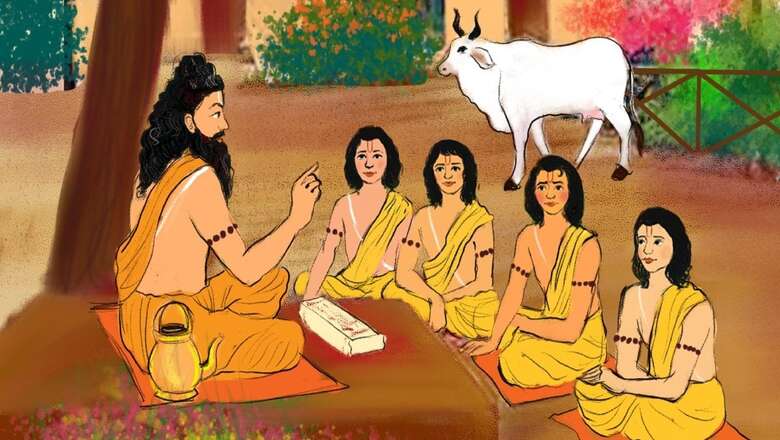
views
Long back in the Nehruvian era, as the anecdote goes, a Soviet delegation with their atheistic beliefs loaded with dialectical materialism, made a trip to India. After their six-month visit, exasperated and puzzled, some of them said that they believed in God. When asked for a reason, they said that in their six-month tour, they found complete chaos, indiscipline, violation of rules, zero commitment to work, corruption and dysfunctionality in politics and public governance systems, despite which this country continues to move on, thrive and flourish. Who runs this functional anarchy; divine agencies, perhaps!
The truth behind this story may stand to doubt; however, the reason behind mentioning this anecdote is my fundamental quest to explore, reason and make sense of what runs Bharat, constituting its core i.e., the engine that keeps this ancient civilisation relevant. Even the staunch advocate of the two-nation theory and the ideological founder of Pakistan, Iqbal, believed that all the great civilisations like Roman, Greek, Egyptian and Babylonian vanished with time; however, India continues with its civilisational roots and legacy. In our recorded history, these roots are at least 5000 years old; however, in spiritual circles, these roots are timeless. What are those forces that prevent this timeless civilisation from decay and disintegration and continue to rejuvenate and revitalise it in its new avatars, in requirements with the changing times and conditions?
The New Quest for Bharat’s Core
In my under-graduation days at Delhi University, I studied India’s history as researched and explored by Romila Thapar, Sumit Sircar, Vipin Chandra, DN Jha, Mushirul Hasan, Irfan Habib, Nilkantha Shastri and many other eminent scholars. Most of them were brilliant scholars with robust academic credentials and publications. However, in our History lectures, the emphasis was always on a certain interpretation of history. Often, we heard professors critiquing BB Lal, Jadunath Sircar, and RC Majumdar popularly referred to as historians with the right tilt, with the findings and theories of Marxist historians like Romila Thapar, DN Jha and Sumit Sircar etc. There were always pre-determined frameworks like generic formulae to understand and narrate history.
The most dominant strand has been the Marxist way of analysing, interpreting and narrating history. Historians airdropped theories and research tools employed to understand European history, Indian history and the evolution of society and culture. Since the Marxist interpretation was in fashion in Western universities, it was considered a lofty ethical duty to superimpose that in India and make sense of, instead complete non-sense of Indian history. In this exercise, the objectivity and dispassionate understanding of history was the biggest sacrifice. Rigorous scrutiny will bring forth the biggest fallacy in this exercise i.e., the foundational epistemology (the theory of knowledge) which constitutes the sources of knowledge. The epistemology in the West has some fundamental differences with the theory of knowledge in Eastern systems. In the West, reason and empirical experience are the two sources of knowledge; however, in the oriental systems, the knowledge revealed intuitively in the deep states of meditative trance constitutes the ultimate and eternal knowledge.
The focus of this piece is not the detailed analysis of this fallacy; but it is being discussed here because it led to the complete marginalisation, neglect and omission of the strongest factor that has shaped Bharat i.e., the spiritual forces.
Sanatana Dharma: Spiritual Forces and India’s Civilisational Journey
If there is any one factor that has the most powerful influence on India’s history across the spectrum of society, politics, art, business and culture, it is the Sanatana Dharma forces. The spiritual forces have played an instrumental role behind every path-breaking revolutionary phenomenon with lasting influence on society, politics and culture for thousands of years. Ramayana and Mahabharata, the two epics with the most powerful influence on Bharat’s collective and individual sub-conscious, have two divine entities, Rama and Krishna, both Lord Vishnu’s incarnations, at their centres, as the principal characters. In the spread of Vedic culture across the length and breadth of Bharat, the Brahmins, monks and ascetics played the most crucial role. The torch-bearers of Sanatana Dharma, revered ascetics like Jamdagni, Atri, Vashishtha, Bhardwaja, Vishwamitra, and Pulatsya are said to have established their monastic establishments in densely forested remote parts of Aryavarta and spread the Vedic culture. The Vedic culture reached South India with the efforts of Agastya rishi, who reportedly blessed Lord Rama with many supernatural weapons. This Vedic culture became the foundation of Bharat/Aryavarta as a Rashtra. The one who ruled the entire Aryavarta came to be known as Chakravartin Samrata.
In India’s written history, the Mauryan Empire — the first centralised and mightiest empire — was established under the mentorship of Kautilya who was an ascetic. During the times of Buddha, India’s socio-cultural landscape was full of seers. Mahavira, Buddha, Carvaka, and Makkhali Gosala were blessed with spiritual wisdom and they shared spiritual insights on the nature of reality, derived from their long and deep meditative experiences. The mighty empires of ancient India like the Guptas, Satvahanas, Chalukyas, Pandyas, Cheras, Cholas, Kushanas etc. had spiritual entities behind them as a leading inspiration. These spiritual entities became the original source of the unleashing of great social, cultural, political and economic phenomena in South Asia and beyond. Buddha and Mahavira were great social reformers who spoke against many social ills like animal sacrifices and influenced many influential men of their times including rulers like Chandragupta and Ashoka Maurya, intellectuals and prominent businessmen. Notably, Chandragupta became a Jain ascetic towards the end of his life and Ashoka adopted Buddhism after the Kalinga war. During Ashoka’s reign, Buddhist religious and philosophical values constituted the soul of India’s soft power. These dharmic influences reached far and wide. Ashoka’s emissaries visited Greece, Sri Lanka, Egyptian and West Asian kingdoms. Ashoka himself visited Khotan in Central Asia in 250 BC. Ashokan edicts with Buddhist messages and injunctions have been found as far as Kandahar in Afghanistan. Buddhism grew into an international religion through trade routes and also inspired the world of art and culture. Gandhara Buddhas with Greco-Roman influence and the mighty Bamiyan Buddha statues are a testimony to the overarching impact of Buddhism. It completely revolutionised the oriental world, becoming a main religion in Tibet, Myanmar, Thailand, Cambodia, Vietnam, China, Korea and Japan.
In medieval India, legendary empire builders who fought against the Muslim invaders were inspired by seers and mystics. Bappa Rawal, the founder of the Guhila kingdom in Mewar (728 AD), took his inspiration and blessing from sage Harit Rishi. Bappa Rawal wrested Chittor from Arabs and is said to have chased invaders as far as Iran. Rawalpindi in Pakistan is allegedly one of the military posts established by Bappa Rawal on his return journey from Iran. Harihar and Bukka, the founders of the mighty Vijayanagara Empire, were initially converted to Islam, by Muhammad Bin Tughlaq, during his military campaign in South India. They escaped the captivity of the invading Muslim Army and took refuge at Vidyaranya and Sayan rishi’s holy abode near the Tungbhadra River. Sayan rishi brought them back to Hinduism, and they established the Vijayanagara Empire, which lasted 300 years keeping the surrounding Muslim states under a firm grip and became a flourishing trade and economic centre. Another great hero of medieval India, Shivaji, the founder of the Maratha kingdom was a disciple of Samartha Guru Ramdas. Samartha Guru Ramdas was a part of the great tradition of Bhakti mystics in the Maharashtra region that began with Gorakhnath, Gyandev, Tukaram and Eknath. In most of the stories associated with empire builders and kings, the mention of spiritual master finds ubiquitous mention. The historicity of such claims may be a subject matter of inquiry, however, the idea itself speaks volumes about the role of spiritual forces in shaping India’s history.
Social Reform and Political Movements
Coming to social reform movements, it is pertinent to mention that religious and spiritual forces played an instrumental role in them. When India was facing an Islamic onslaught in the form of rampant conversions and temple demolitions, there was an overwhelming hopelessness. On the sidelines of military victories, the Sufi saints were converting Hindu lower classes en masse. At this juncture, the Bhakti movement emerged as the paramount force against advancing Islam. A large number of Bhakti saints such as Pipa, Sen, Dhanna, Tulsidas, Rajjab, Dadudayal, Kabir, Raidas, and Palatdas became the flag-bearers of Sanatana Dharma. They revived and revolutionised the Sanatana, defying the caste norms and presenting an egalitarian face of Sanatana Dharma.
It was a massive social revolution orchestrated and staged by spiritual forces. They emphasised caste equality and simple devotion, condemned ritualism, resolved Hindu-Muslim differences and preached an inward journey through mediation and devotion where all the duality ceases to exist. With their simple teachings, they rejuvenated Hinduism and arrested the spread of Islam. Many of those saints left a lasting imprint on the subconscious mind of an average Hindu. Till today, Kabir’s bhajans are sung in almost entire North India and Tulsidas’s Ramacharitmanas continue to have the most profound impact on the collective psyche of Hindus.
Sikh gurus fought valiantly against the Mughals. The spiritual masters became warriors under the leadership of Guru Teg Bahadur and continued the fight under Guru Govind Singh Sahab. Guru Govind Singh formed the Khalsa cult and transformed the Sikh peasants into warriors. In Banaras, the militant naga and nathpanthi monks fought bravely against the Mughal army sent by Aurangzeb to demolish the Kashi Vishwanath temple. Against the British, many subterranean revolts were led by religious leaders and spiritual entities. The Kuka movement (1870s) led by Sikh monks, initially against cow slaughter, turned into an anti-British movement, aiming to overthrow British rule. Other examples include the Sanyasi rebellion (1770-77) of Bengal, primarily led by Dasnami Naga Hindu ascetics. Birsa Munda, who led the Munda and Oraon tribals against the British rulers of the Calcutta Presidency in the late 19th century, was also a seer, revered as Bhagwan Birsa Munda by the tribal followers. He led the tribal people against British Christian missionaries, forcible conversion and their land-grabbing practices. Hindu monks and Muslim fakeers also played an important role in the revolt of 1857, as messengers and motivators.
Interestingly, according to some stories, spiritual forces played the main role in the formation of the Indian National Congress (INC), which led to the freedom struggle against the British. Vipin Chandra in his book, ‘India’s Struggle for Independence’ mentions that a Himalayan yogi baba, Koot Humi Lal Singh, impressed AO Hume, the British civil servant by reproducing a copy of viceroy’s secret letter through his supernatural powers. He told him that the British needed to do something as India was about to revolt on the lines of 1857. AO Hume, alarmed by such predictions, founded the INC as a safety valve to give vent to the public angst against the British, through a political organisation.
Arya Samaj, the revolutionary social reform movement among the Hindus that inspired generations of entrepreneurs, completely revolutionised the religious space of the Hindu middle class, waged an ideological counter against Islamic extremists, led Shuddhi and Sanghthan movements to bring back converted Muslims to the Hindu fold, was started by a Hindu monk Dayananda Saraswati. Swami Vivekananda, who enthralled the Western audience with his mesmerising speech about oriental religions in the World’s Parliament of Religions in Chicago (1897) and had a very powerful imprint on the minds of Hindu youth, was a Hindu saint and disciple of Ramakrishna Paramhansa, a great devotee of Goddess Kali. The trio of Ramakrishna Paramhansa, along with Maharishi Dayananda Saraswati and Swami Vivekananda have the most powerful influence on modern-day Hinduism in India. During the non-cooperation movement (1920-21), several micro-level variants of that movement started in various parts of India in which religious leaders played a key role. Sitaram Baba led the Bedakhal movement against rapacious land revenue practices of the British in eastern UP. Alluri Sitaram Raju, who waged a guerilla war against the British in 1924, leading the Rampa rebellion, was also a Hindu ascetic. Initially, as a sanyasi, he began his tirade against conversions by the Christian missionaries. His popularity as a charismatic sanyasi won him thousands of followers who believed in his invincibility. Notably, Mohandas Karamchand Gandhi’s connect with the masses transforming him into a larger-than-life phenomenon is also largely due to his image of a pious ascetic, a Mahatma. Had he projected himself as a politician, his stature would have been diminished long ago. Several Arya Samaj monks like Swami Shraddhananda and Swami Sahjanand Saraswati played a crucial role in the anti-British struggle and agrarian movements.
In the post-independence period, enlightened Indian spiritual masters like Paramahansa Yogananda, Maharishi Mahesh Yogi, Swaminarayan Sanstha, Satya Sai Baba, Osho Rajneesh, Sri Sri Ravishankar, Jaggi Vasudev, etc carried the message of yoga and meditation to the Western world. The kind of following these modern-day spiritual masters have, makes them parallel kings of an undefined territory and unspecified constituency of followers. In foreign lands, they are the most credible carriers of India’s soft power. In domestic politics, their one word can drastically alter the contours of the elections and the fortunes of big leaders. Institutions like Swaminarayan Sanstha have done such excellent work in public service and humanitarian relief in Gujarat that can challenge even the most effective and advanced public delivery systems and governance.
Amongst all these, Osho Rajneesh had almost staged a coup in the Western world. With his message of meditation and humanism, he became immensely popular in the West, almost a revolutionary figure and came to be perceived as a great threat by the Christian clergy and the state, in the West. Even in Modi’s thumping 2014 victory, the role of Baba Ramdev, a Hindu monk better known for his work in revolutionising yoga and Ayurveda, has not yet caught the attention it merits, from the scholars of political science.
The Rashtriya Swayamsevak Sangh (RSS) had been in existence for almost 100 years now, working on the grassroots and propagating its Hindutva message. However, the RSS and other right-wing political, social and cultural outfits could never find that all-encompassing connect with the masses and unflinching followers with commitment because, in popular perception, they lacked the spiritual essence. However, religious men like Baba Ramdev could accomplish that connect because of the sheer power of religion over the minds of the people. Baba Ramdev, with his accomplice Rajeev Dixit, was organising yoga camps across the country, where he openly spoke about India’s ancient glories and achievements in the past. Blaming the British and the ruling regimes that followed the departure of the British for their anti-Hindu, pro-Islamist and anglicised policymaking, he created a robust anti-Congress narrative on the pillars of corruption, Islamist appeasement, pro-Western attitudes and anti-Hindu policies. Finally, this was followed by a series of scams, bomb blasts and the Congress-led UPA government’s failure to address these challenges. The last nail in the coffin was the lathi charge ordered by Chidambaram’s home ministry on Baba Ramdev, who was peacefully protesting against corruption with his supporters. The brutal and horrifying episode, reminding one of the Chekha police or Gestapo, left a deep-seated resentment and grudge in the heart of Hindus because a Hindu monk was beaten, thrashed and humiliated for no crime of his. The episode signalled that the Congress party had an inherent hatred for Hindus and that their future is not safe under the Congress rule. That episode reminded the Hindu common folk of the police firing, on Hindu monks protesting against cow slaughter, during the Indira Gandhi government after which, reportedly Karpatri Maharaj, a revered Hindu monk cursed Indira that she and her family would meet a political decline and ruination. Not to lend any scientific credibility to the monk’s curse; however, the final outcome of this episode was more than evident in the election results of 2014.
To be continued
The author is a Cornell University graduate in public affairs, bachelors from St Stephen’s College, Delhi and has done his PhD on Jaish-e-Mohammad. He is a policy analyst specialising in counterterrorism, Indian foreign policy and Afghanistan-Pakistan geopolitics. The views expressed in this article are those of the author and do not represent the stand of this publication.




















Comments
0 comment